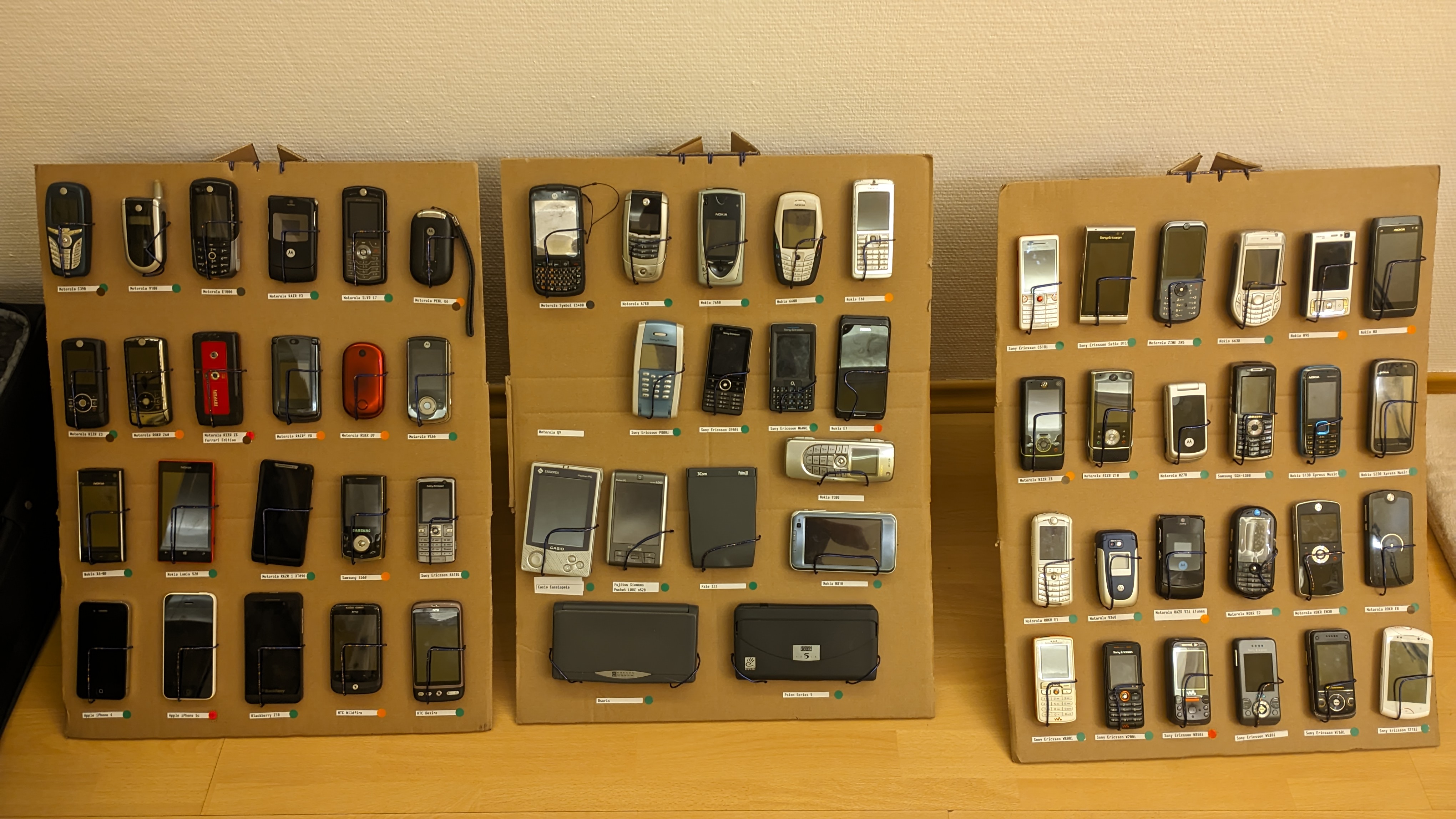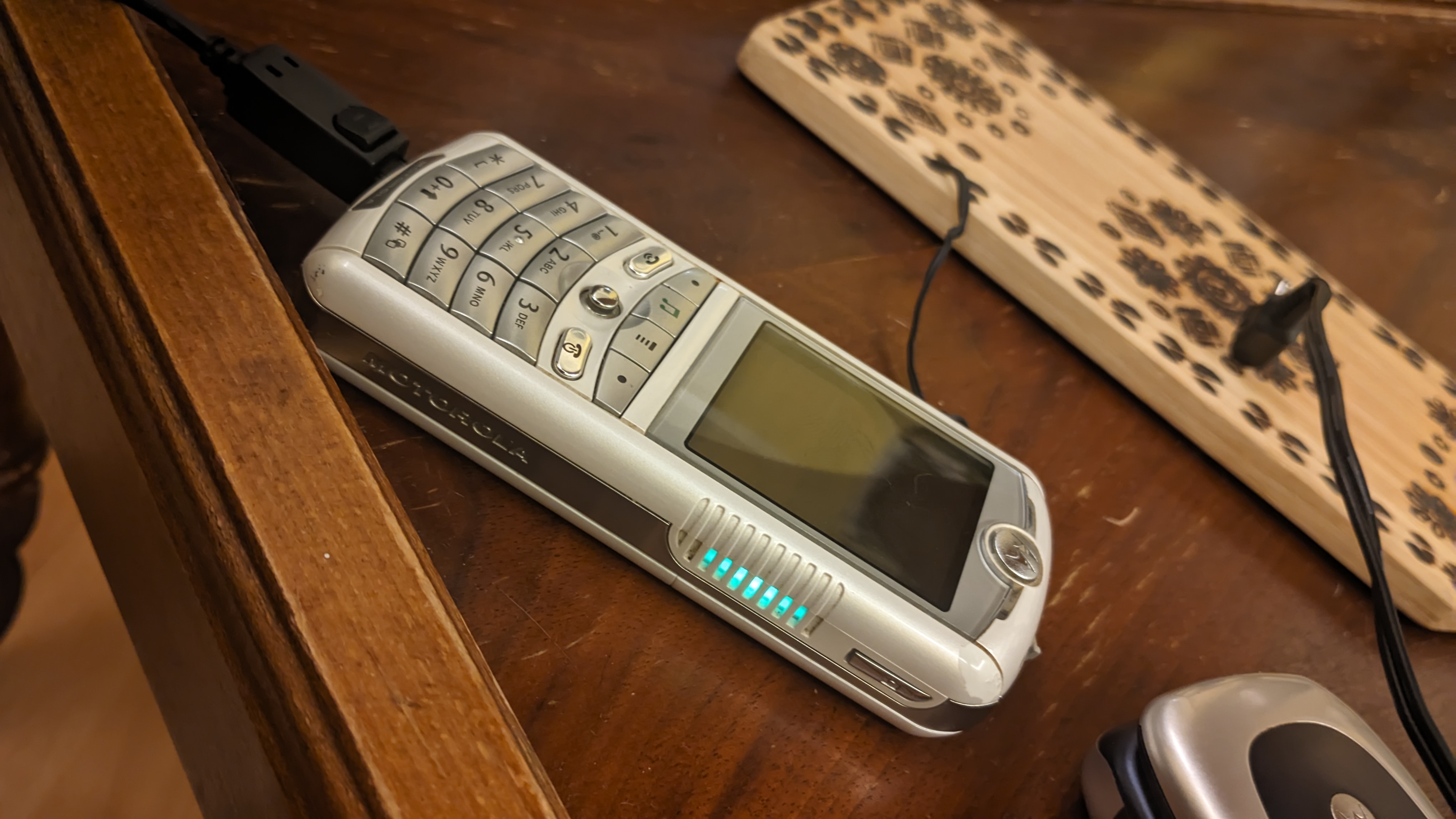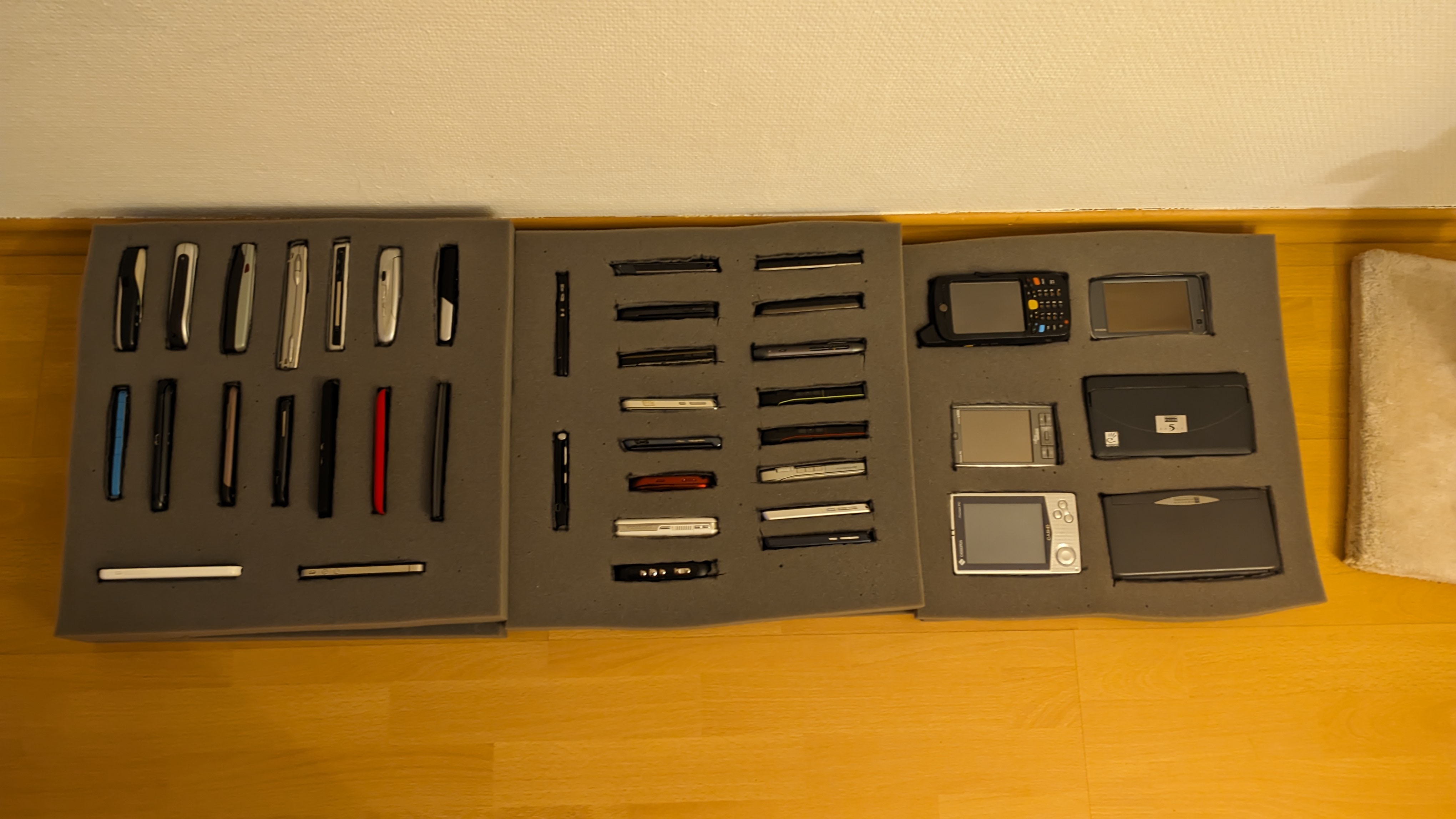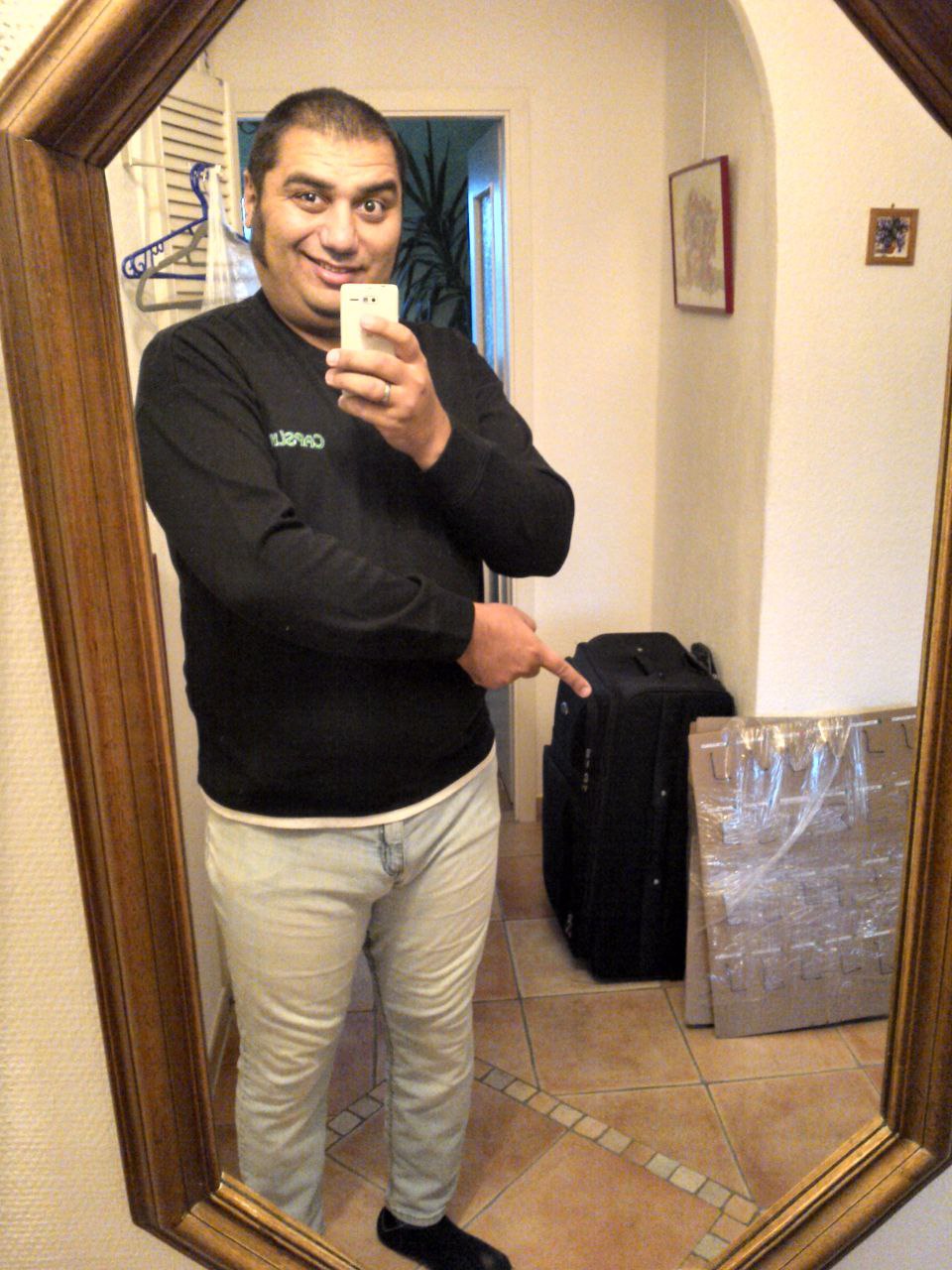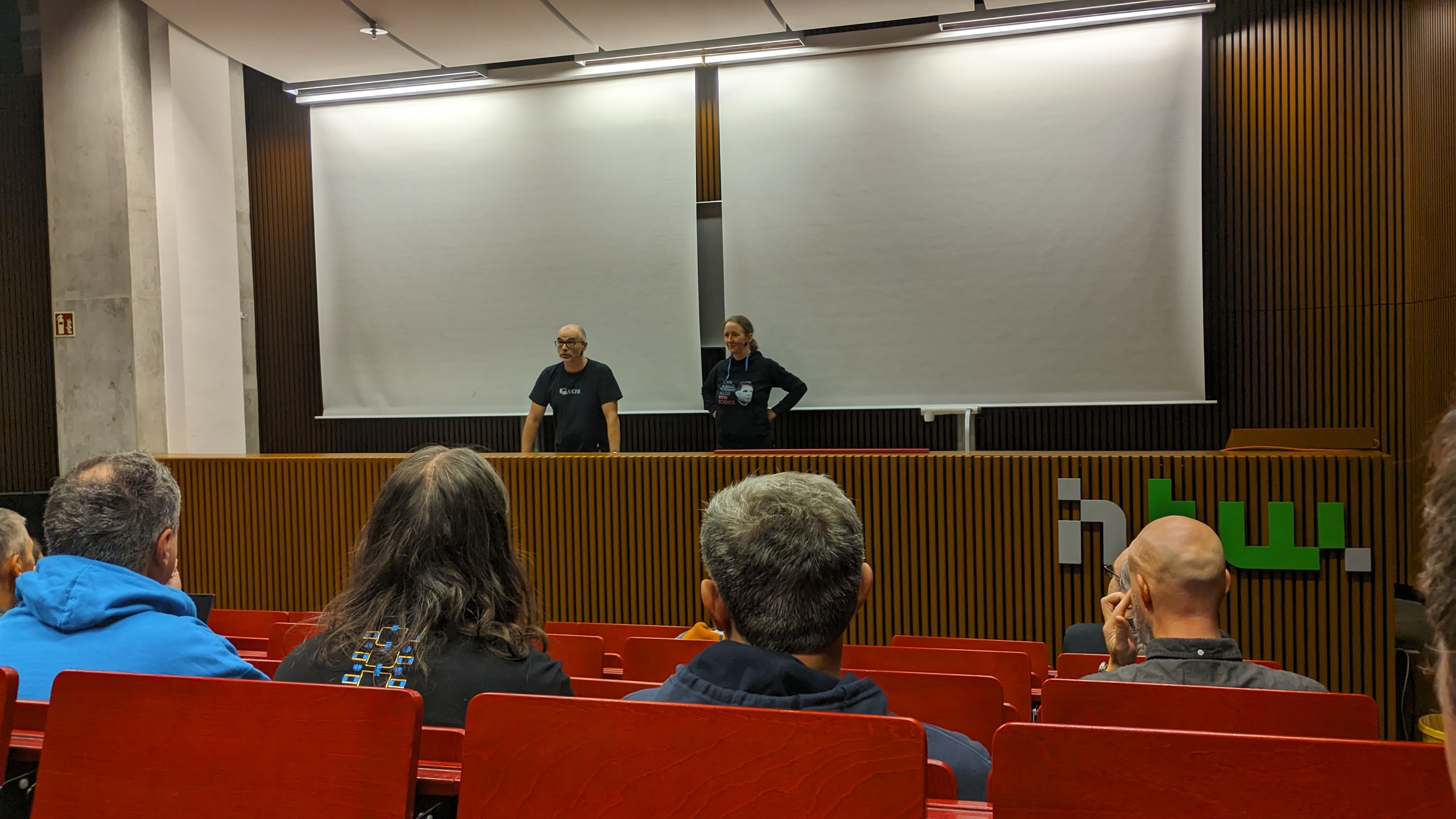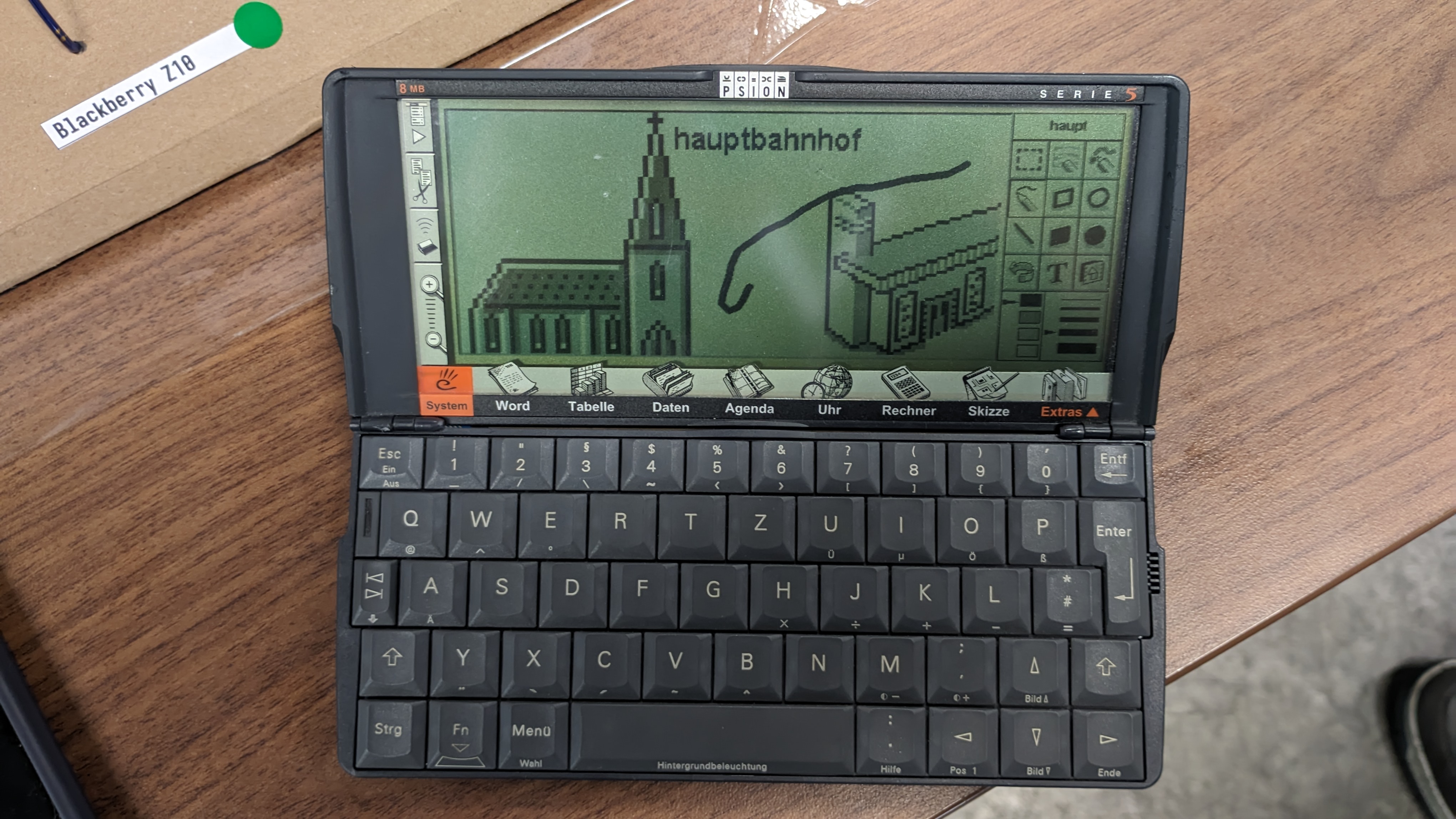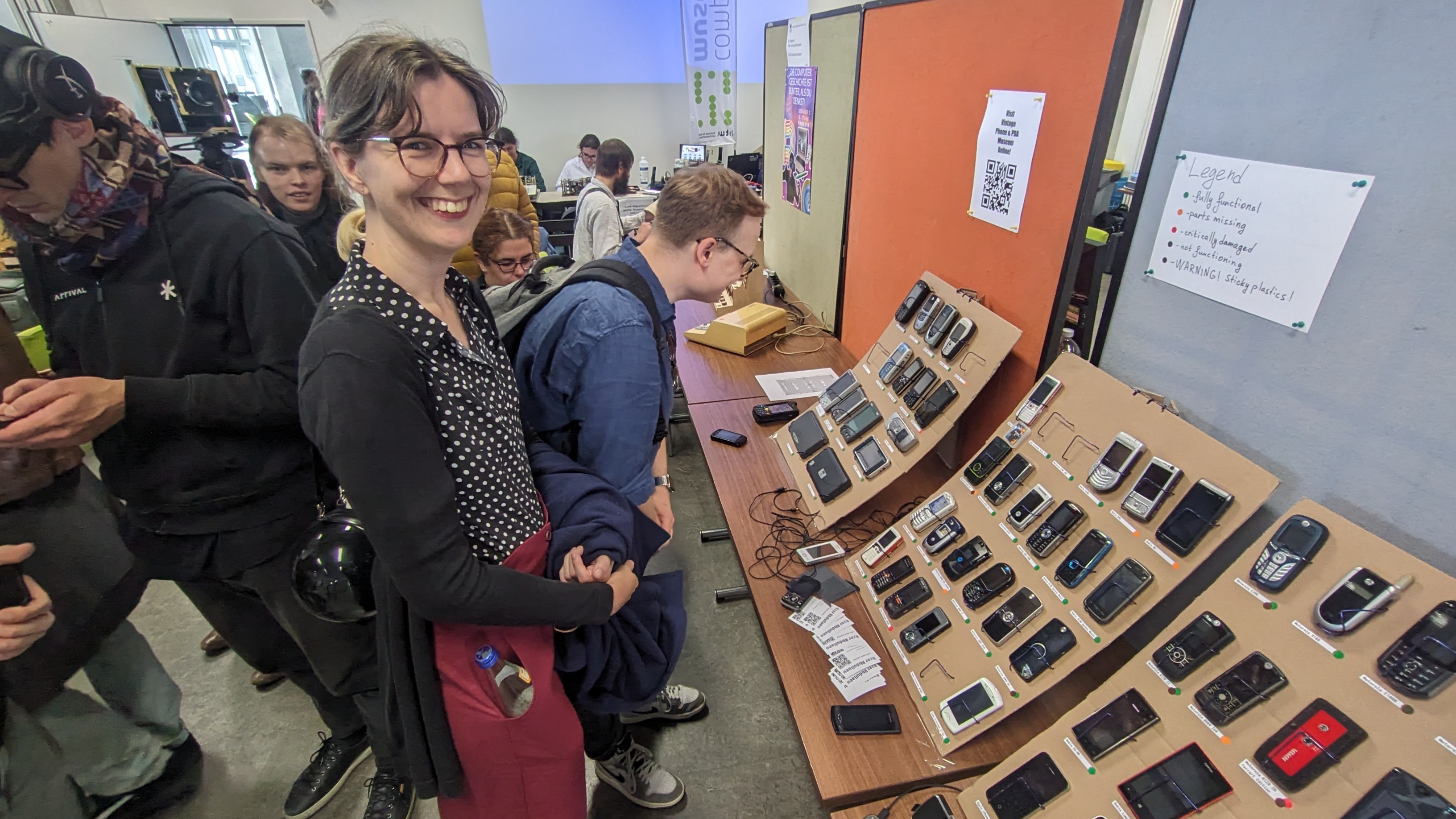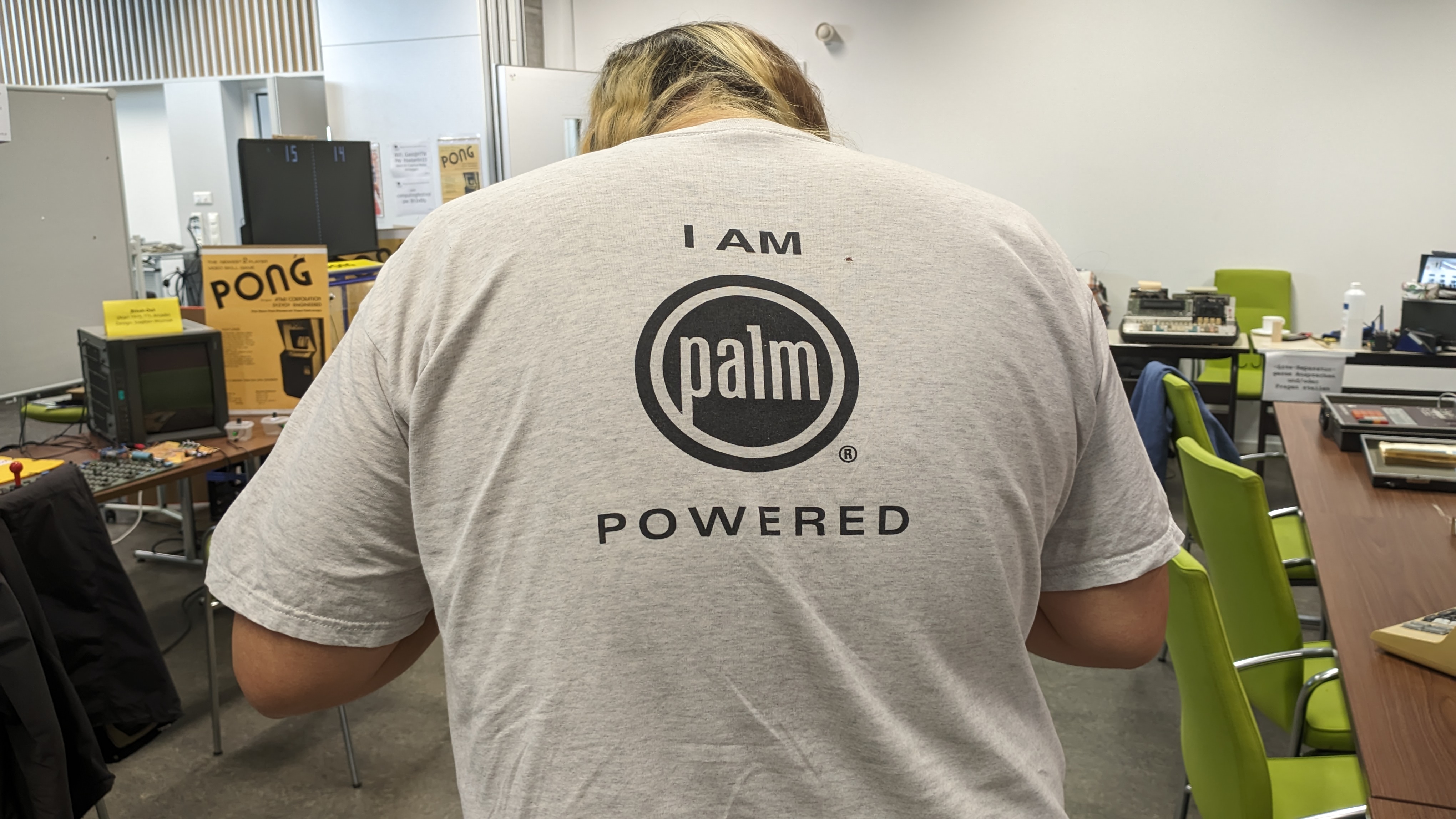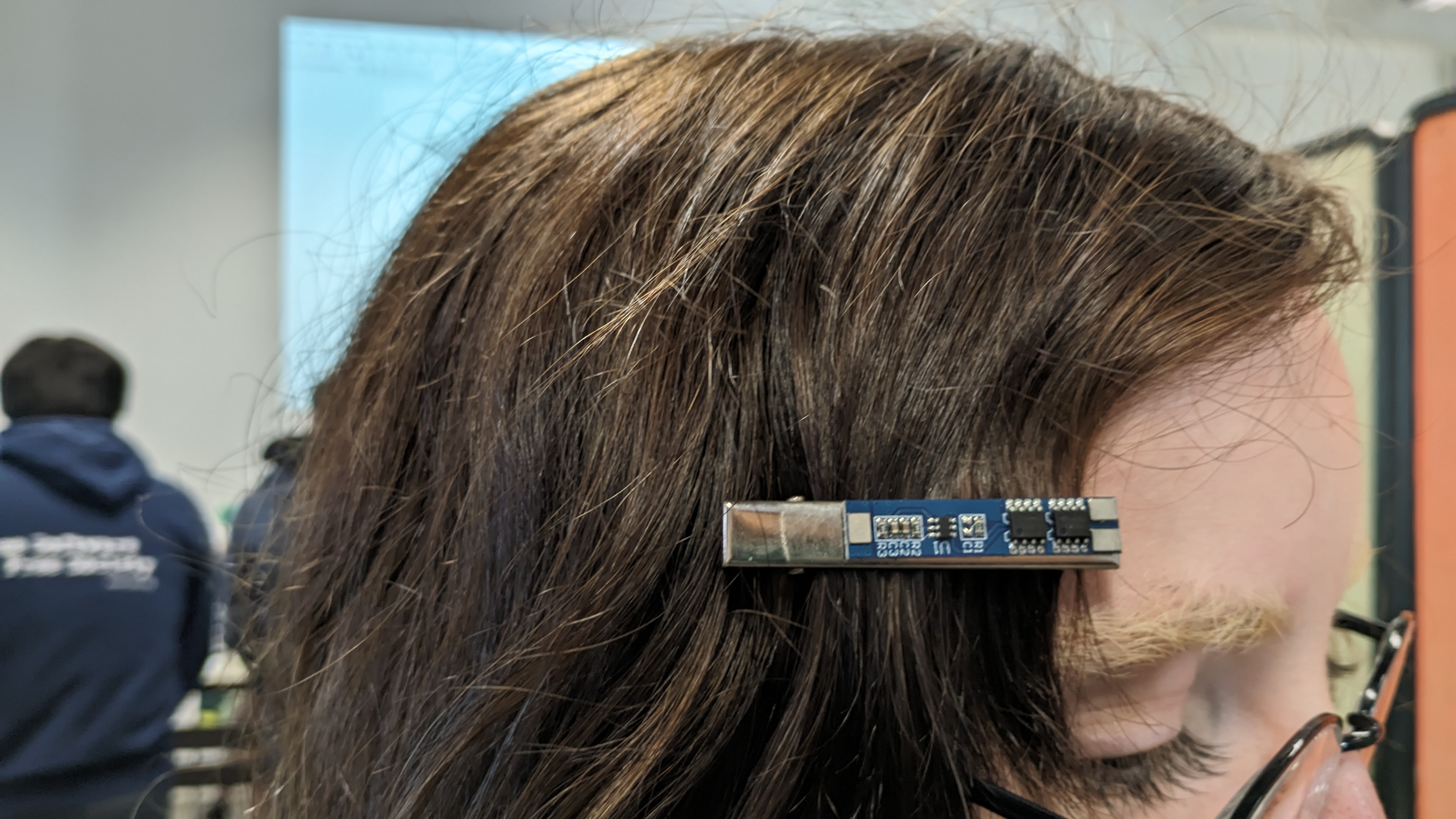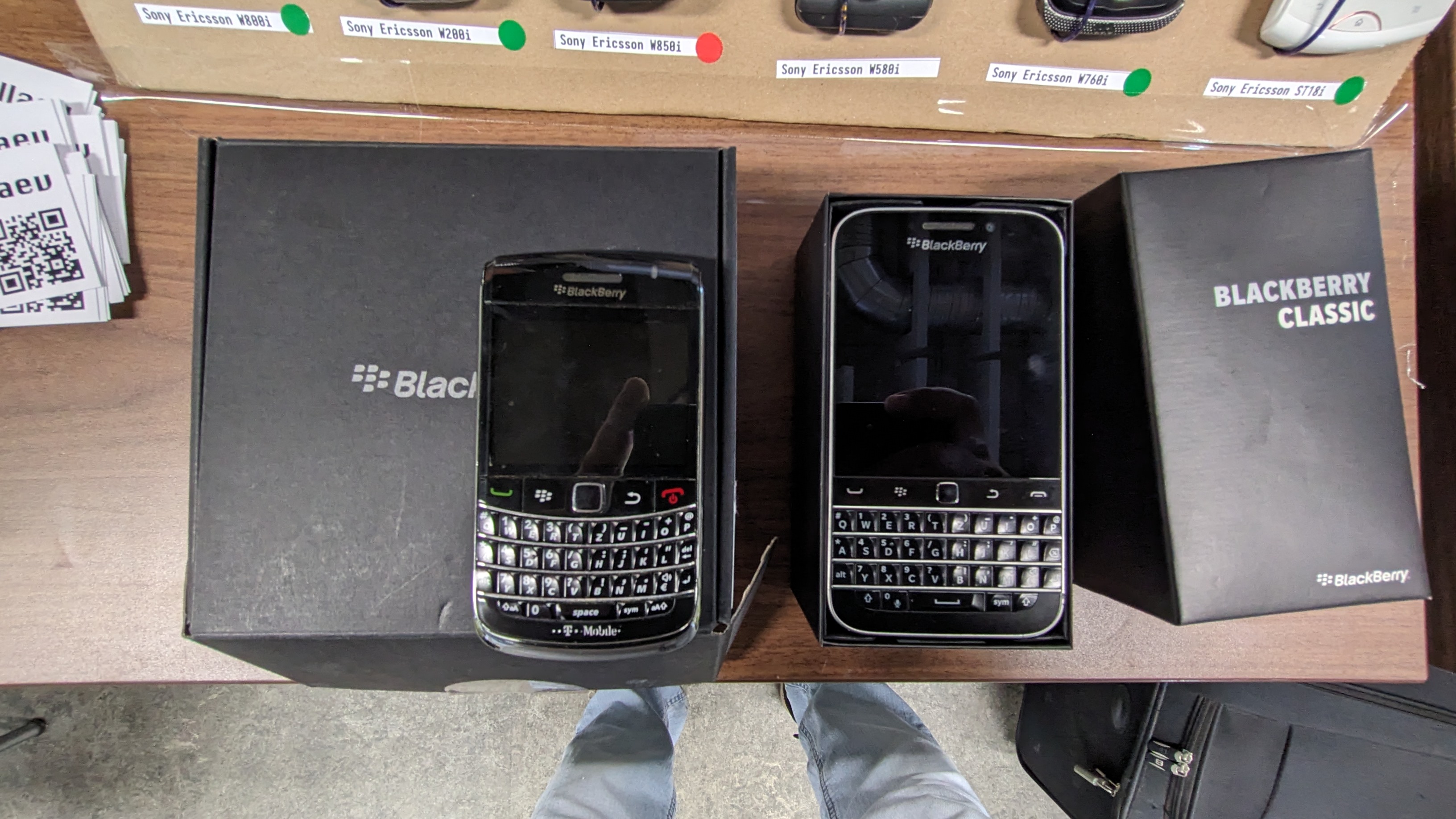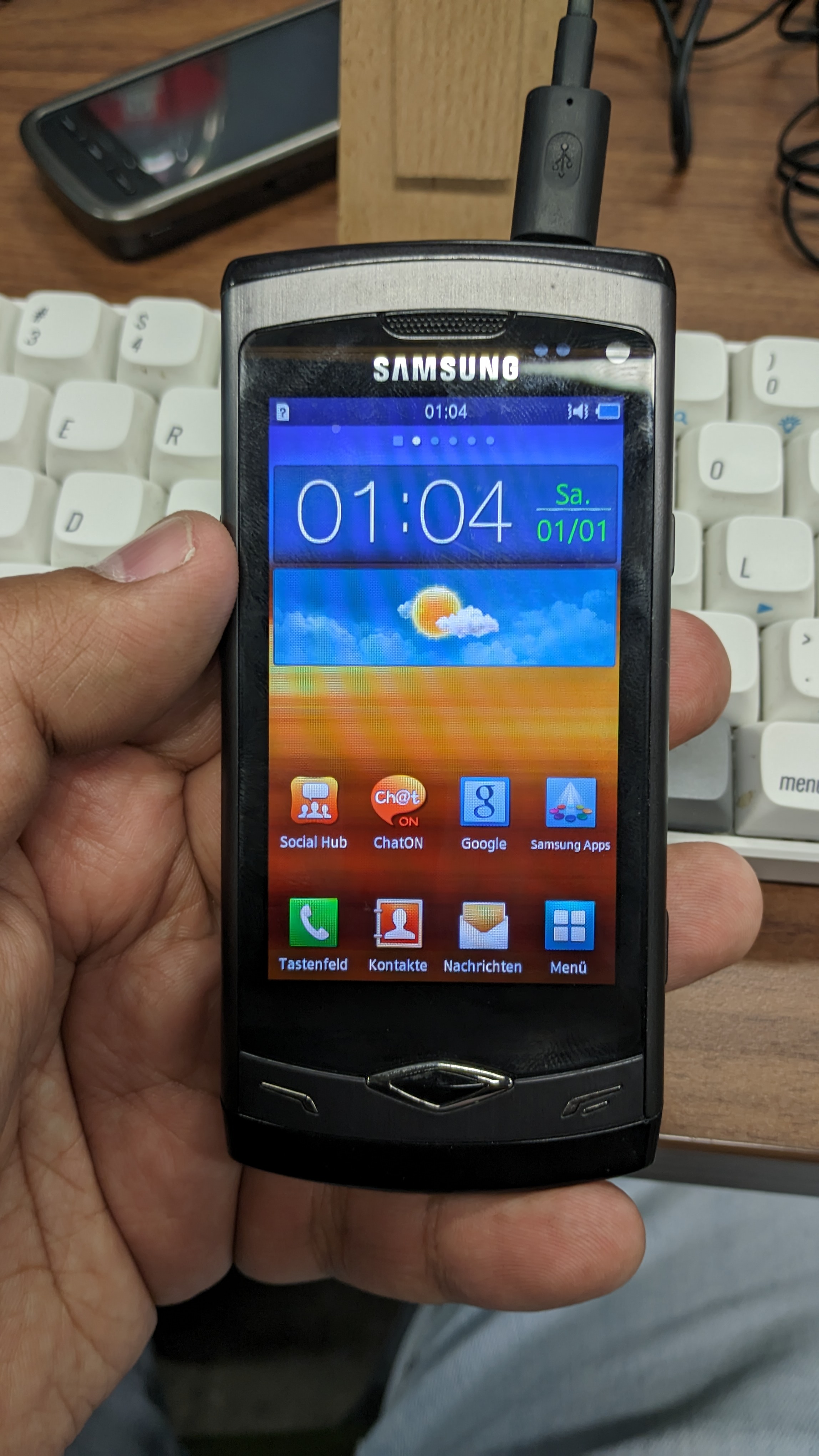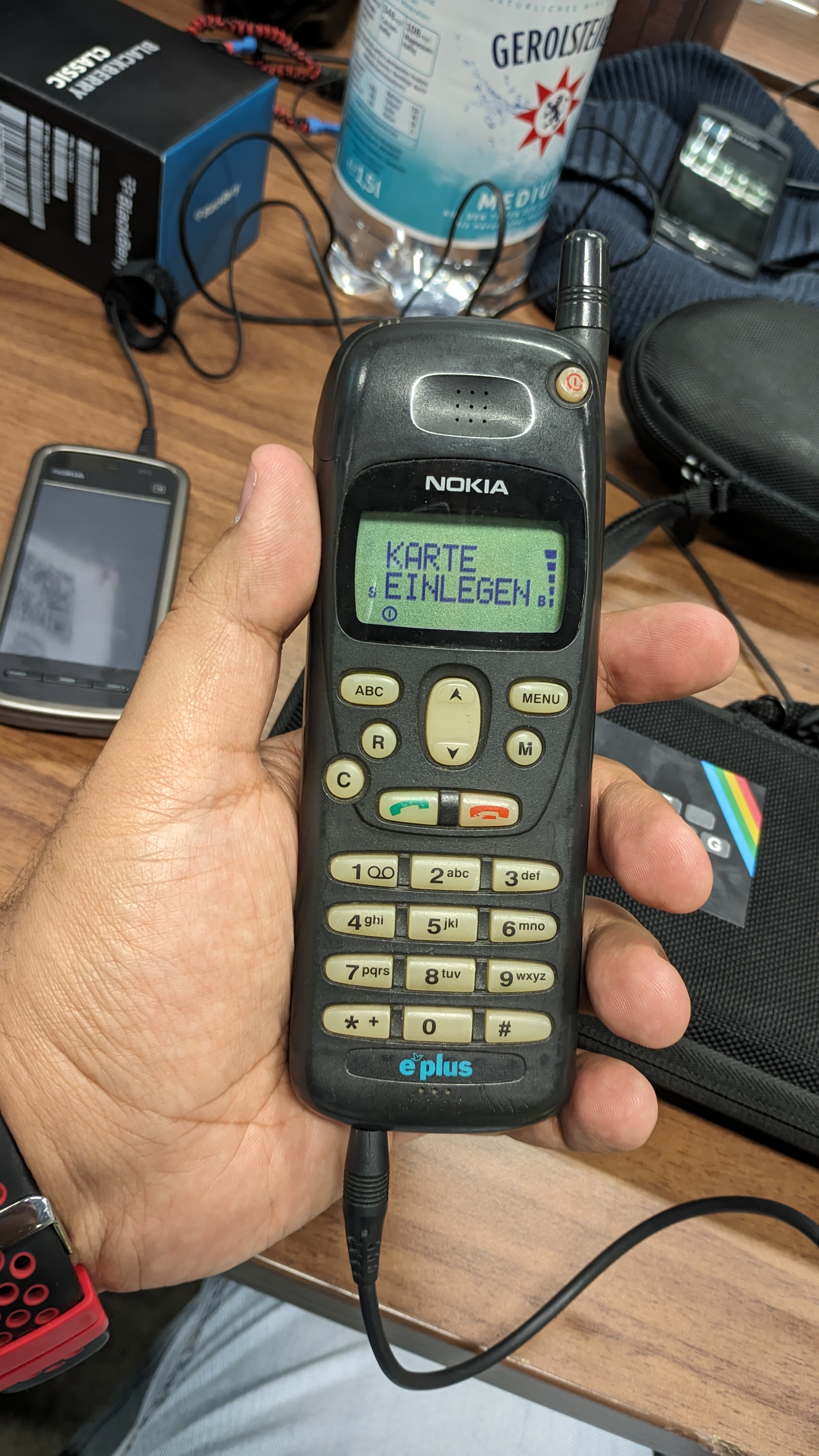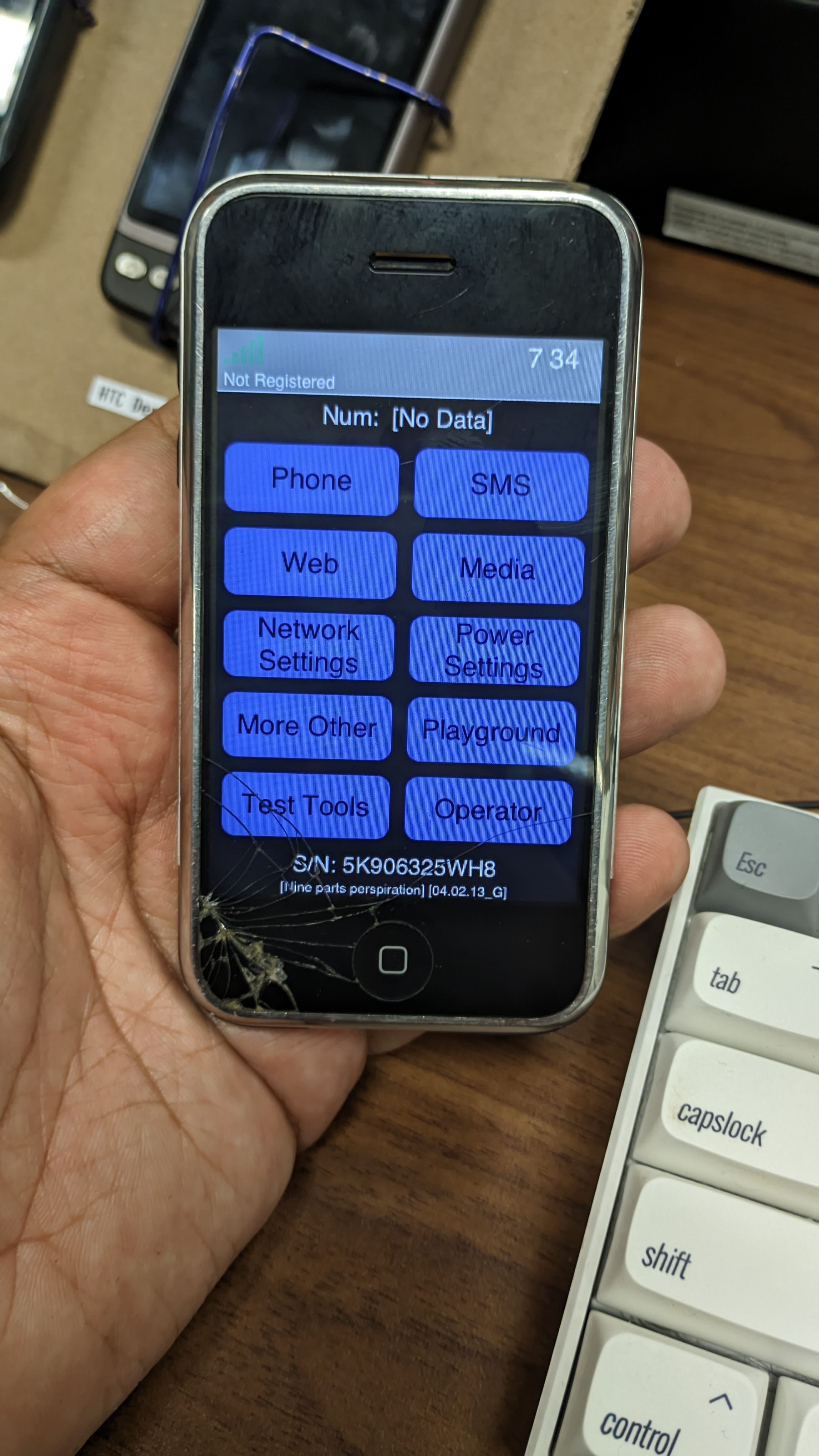Vintage Computing Festival Berlin 2024, Report
Well, I’ve made it a rule that if I’m struck by another wave of inspiration, I should make the most of it while it’s still full steam ahead. Strike while the iron is hot, as they say. Since 2023, my personal collection of vintage mobile phones has doubled, and by the time of the event, it had reached around 65 devices, 63 of which I brought to my booth at the VCFB 2024 for everyone to see and explore.
Initially, I expanded the collection with the goal of telling the full story of the Symbian operating system, starting with EPOC on Psion PDAs and ending with Nokia Belle. Of course, I haven’t managed to collect everything yet — the Nokia 808 PureView and Ericsson R380 are still expensive as hell, but I haven’t lost hope. Along the way, I picked up other models that deserved a spot in the display, like PDAs and smartphones running Windows Mobile (some of which even have built-in hard drives) or, for example, the infamous Motorola ROKR E1, which didn’t gain much popularity but paved the way for Apple’s first iPhone.
As a result, my exhibition display was divided into three sections: Business, Entertainment, and Lifestyle. The first section focused on smartphones and PDAs with business features, allowing their owners to handle important (or not so important) tasks on the go; the second section highlighted entertainment, covering music, photos, and videos for now, with games possibly coming later; and finally, phones and smartphones as a form of self-expression! I definitely couldn’t imagine life without that. Now, let's go over it all in order.
Preparation
With more devices on hand and the same limited transport and display equipment, I needed to figure out how to handle packing, transporting, and setting up the exhibit at the destination. This time, we were allowed to set up in Building G on the campus of the Hochschule für Technik und Wirtschaft Berlin (HTW for short). Not the most convenient location, but I’m not the organizer — ultimately, it didn’t affect attendance, as people came anyway.
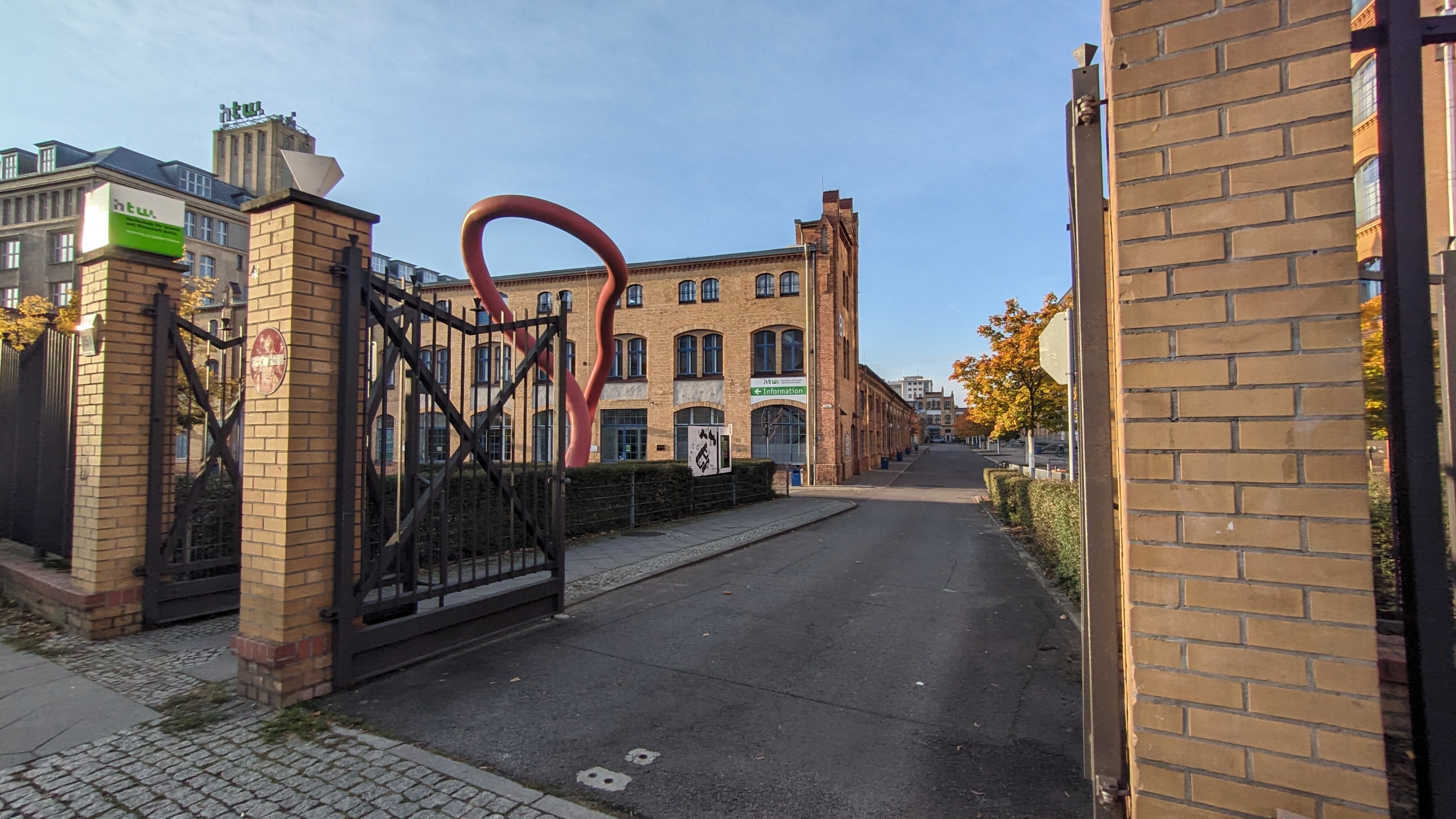 The university welcomed us with wide gates and an unusual sculpture
The university welcomed us with wide gates and an unusual sculpture
So, to transport all 63 devices safely, I had to invent some packaging. The most logical solution was foam blocks with custom-sized slots for the phones and PDAs, which I then stacked in a suitcase. Alongside them went the “nasty bag” — a paper bag filled with a tangled mess of charging cables, which quickly became a subject of jokes and memes. Thanks to the EU for finally pushing Apple to switch entirely to USB Type C!
An improvised solution was used for the stands as well: I had some sturdy cardboard lying around in the basement, to which I added garden decorative wire and used a hand drill and hot glue gun. It was almost as if it was built out of sticks and stones. The structure bent under the weight, but it did the job. The work of assembling the stands and packing the devices took up nearly all of my free evenings that week. To avoid distractions, I moved my main smartphone to the next room and enjoyed music from a floppy disk player in the living room — replaying live recordings from my favorite musicians, with some new additions to my chart that I’ll tell you about toward the end. Planned work and careful time management paid off, and I finished everything on time for the event. Everything was ready, packed, and awaiting dispatch.
Festival
As always, I woke up early on Saturday, had a hearty breakfast, got myself ready, took a selfie on an old smartphone, and headed out, from S Südkreuz to S Schöneweide, with a short walk from there. The campus was huge but welcoming and quite a pleasant place. Universities still feel like hubs of energy and youth. I had to search a bit for Building G, where the festival was held — it was situated by the river, but the riverside path was closed, so I entered through the main entrance.
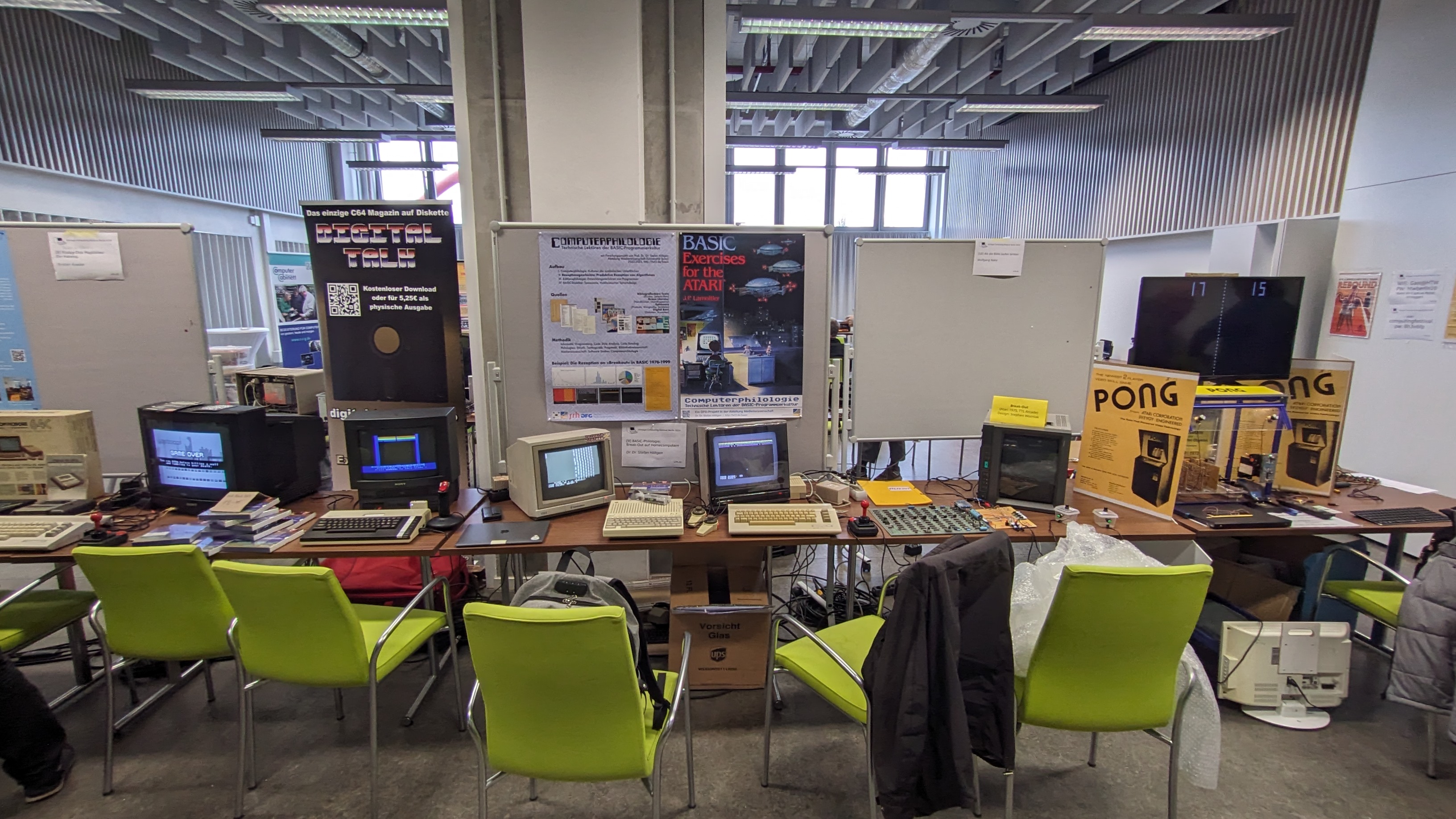 Most exhibits I had already seen at the previous event
Most exhibits I had already seen at the previous event
Inside, I was greeted by familiar faces showcasing their Atari, ZX Spectrum, Amiga, and my favorite, the Tandy TRS-80. For the next two days, this space was ours. Last time, we had a few rooms and a general feeling of spaciousness, but this year we were a bit more compact, setting up on desks placed back-to-back and separated by pinboards. Still, it was cozy, and no one was bothered. I set up my stand, unpacked the suitcase, taped the display stands to keep them from sliding under the weight, plugged in the most interesting devices to charge, removed extra chairs for better access to the exhibit, hydrated, and headed to the auditorium for the opening briefing.
As always, we were welcomed, sponsors were thanked, the Bill of Rights Code of Conduct was read, and we were wished the best possible festival experience. Now, it was time to await the most important moments of the event.
Visitors
No exhibition or festival would have any meaning without visitors. It wasn't like the doors opened at exactly 10:00 a.m. and people rushed in all at once; it was more of a gradual flow. Nevertheless, for the next ten hours, until 8 p.m., I didn’t have a moment to sit down or take a break! The crowd was bright and incredible, and although I had to switch between three languages (English, German, Russian) while keeping a fourth (Ukrainian) in reserve, I still managed to attract a lot of attention to my exhibit.
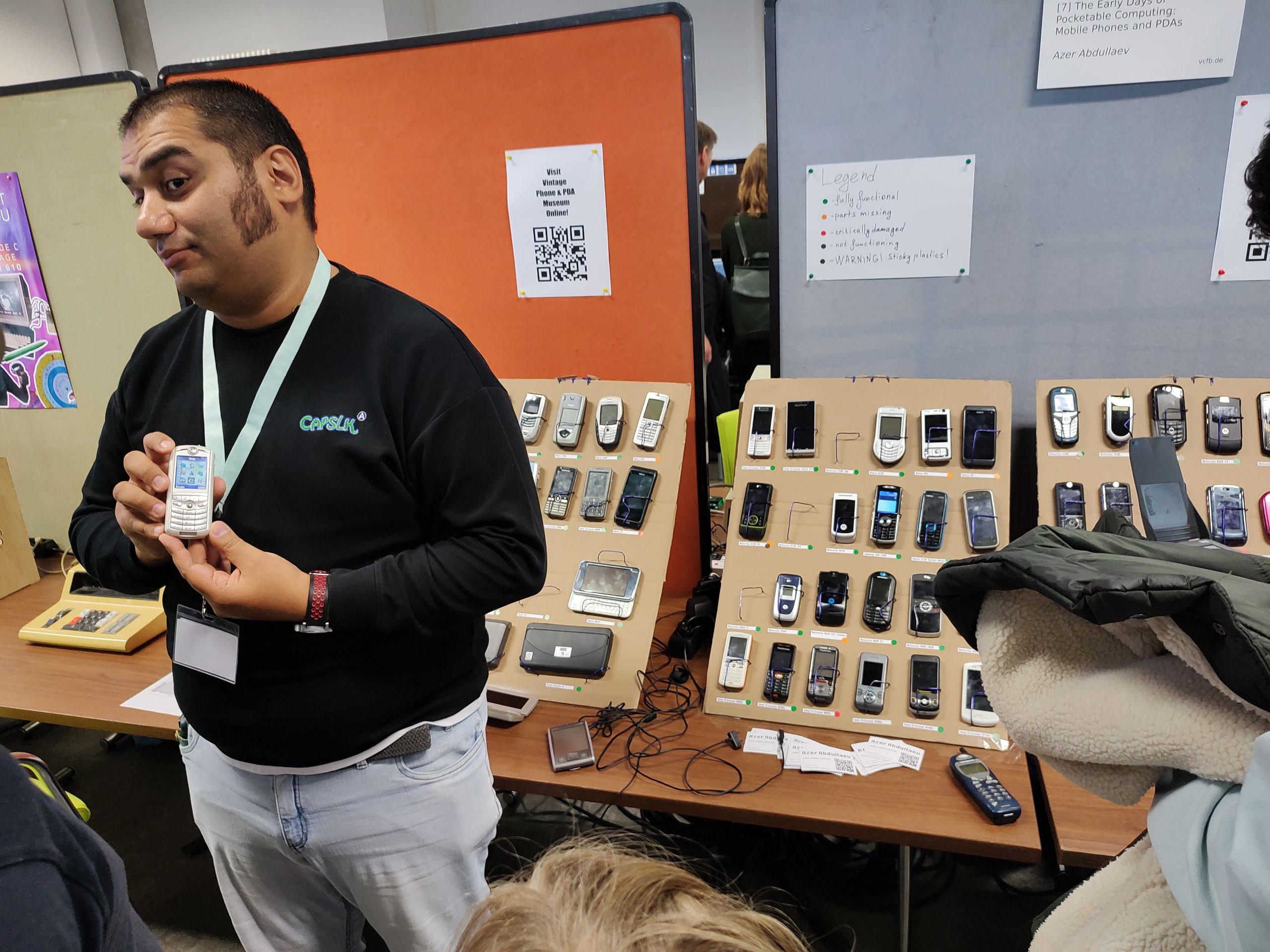 Enthusiastically sharing the story of the Motorola ROKR E1
Enthusiastically sharing the story of the Motorola ROKR E1
The expanded collection drew special interest because, in addition to well-known devices, it featured quite obscure models previously available to a very limited audience, like Psion PDAs, which were targeted at serious executives in suits with personal drivers.
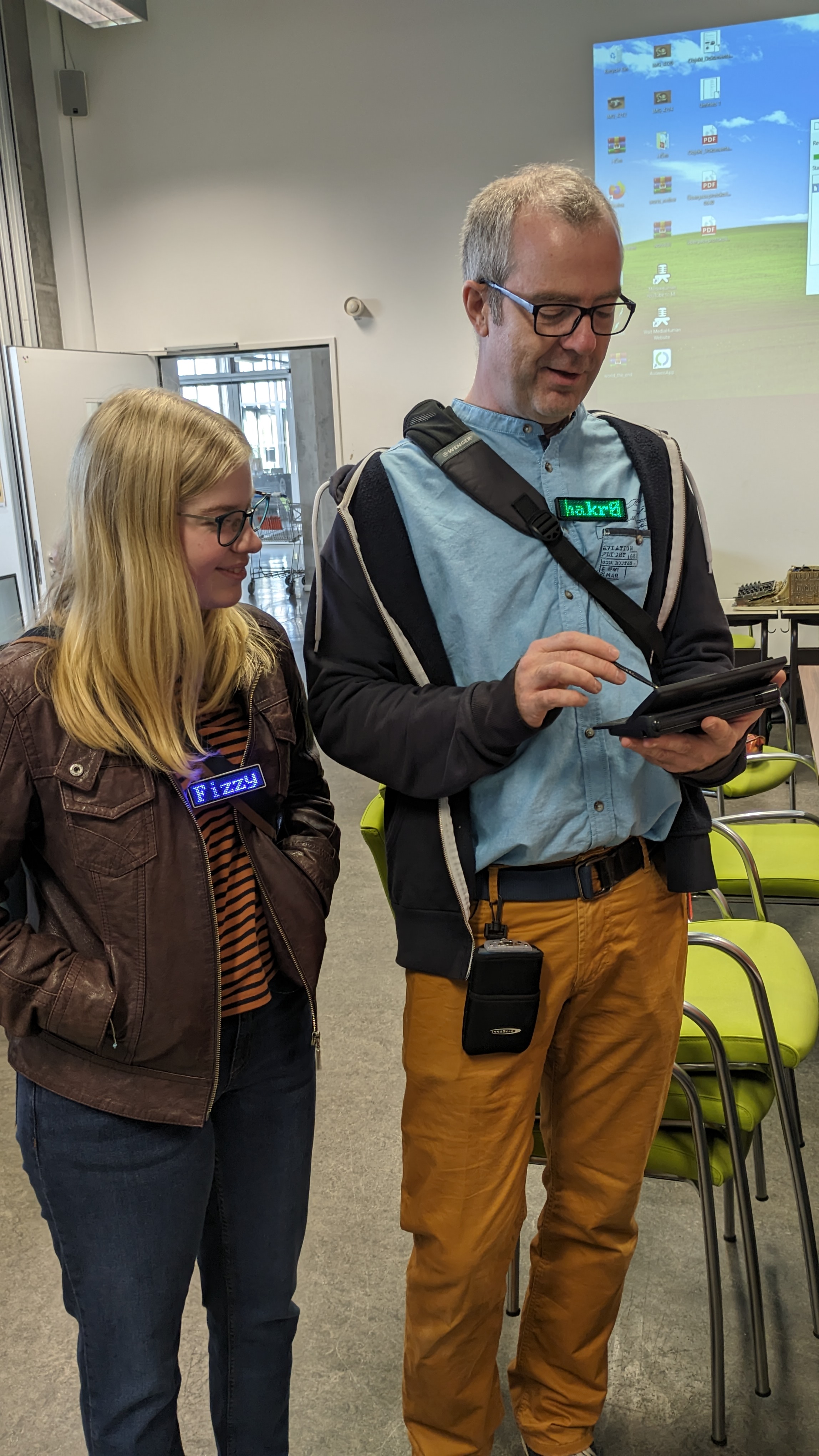 Cool visitors exploring the Psion 5 MX
Cool visitors exploring the Psion 5 MX
Some visitors delved so deep that they almost created masterpieces. One person took a Psion, sat down with it in a corner, and spent a long time working with the stylus. The result was a drawing created without stencils or clip art!
But it wasn’t just PDAs that were the stars of the show. Festival guests were interested in different models of phones from different eras, recalling which ones they used to carry in their pockets. Often, I managed to surprise the crowd with interesting facts, such as:
- The Symbian OS resulted from a collaboration between Motorola, Nokia, and Ericsson, whose consortium adopted the real-time OS EPOC, branded it, and developed several different graphical interfaces that were incompatible with each other.
- Even within the consortium, there was competition. Nokia developed its own interface for button phones, now known as Series 60 (up to version 5), while Motorola and Sony Ericsson opted for UIQ, an interface more suited to PDAs and communicators.
- Around this time, Ericsson transformed into Sony Ericsson, as their factory burned down, and they needed a partner to continue producing mobile phones.
- Motorola later left Symbian to develop its own mobile OS based on Linux. However, something went wrong, as they couldn’t get 3G to work on the new platform (possibly due to chipset issues), so in 2006, after a three-year break, Motorola rejoined the consortium, leaving behind two unique but slightly flawed models and a few rare prototypes, each now worth a fortune.
- One of these phones, the Motorola RIZR Z8, holds the world record for the highest phone call, made from the peak of Mount Everest.
- In 2009, UIQ Software went bankrupt, and both Motorola and Sony Ericsson were at a crossroads. The former went all-in on Android, still in its infancy, while the latter opted to license Series 60 Version 5, as Samsung had done earlier (with its own array of unique quirks like TouchWiz).
- Three years later, Symbian itself ceased to exist. There was an open-source release, but by then, it had lost relevance.
And that was just one operating system, leaving a significant legacy in the world of mobile computing devices that, for a time, showcased countless platforms. That is, until we succumbed to the Apple and Google duopoly.
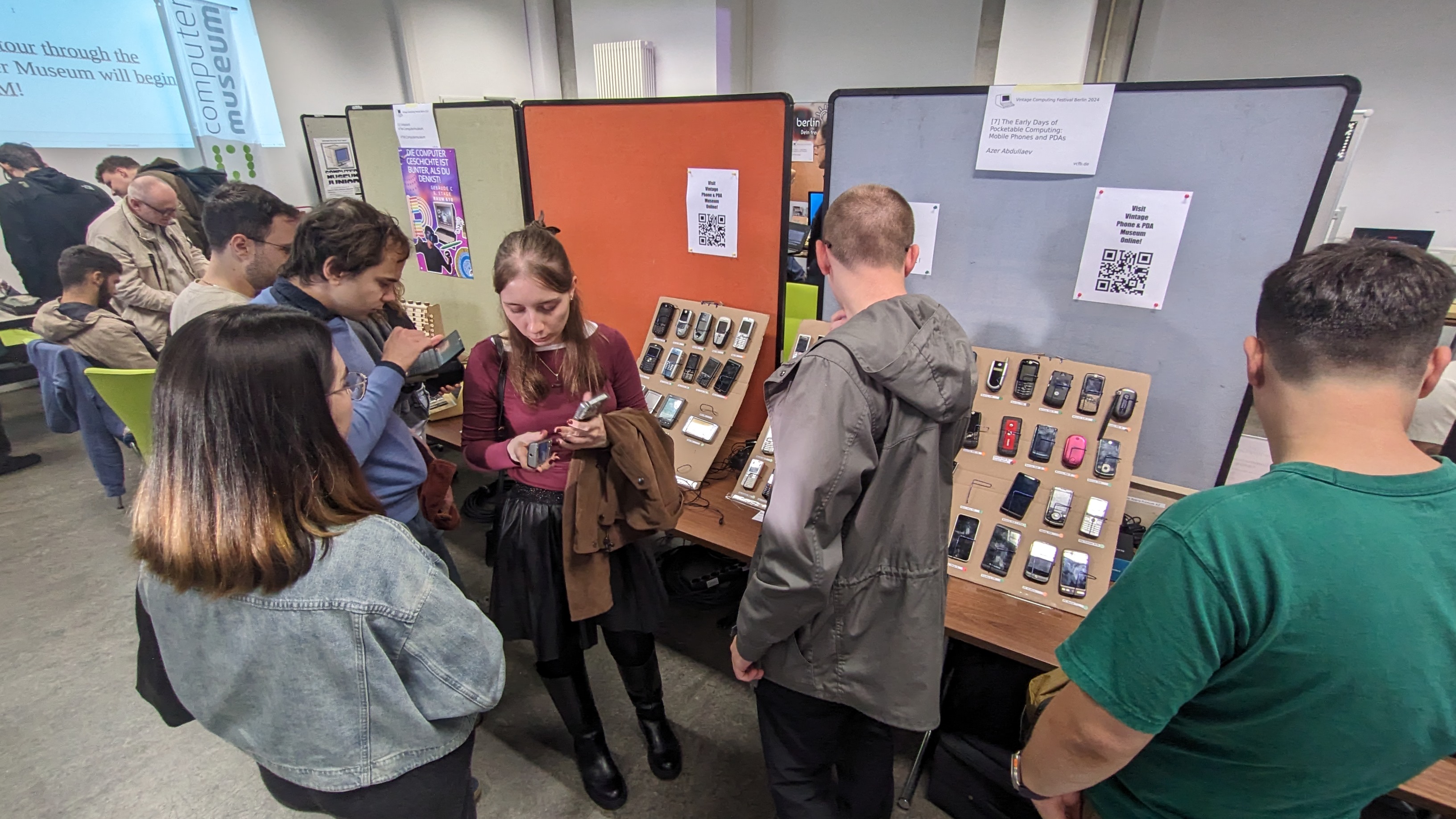 Guests exploring the mighty dual-slider Nokia N95
Guests exploring the mighty dual-slider Nokia N95
The most valuable thing visitors gave back was smiles, emotions, and stories. That’s what it’s all for — for the pure joy and curiosity. The crowd at these events is always unique, and seeing all these outfits and wearable devices is a pleasure in itself.
Friends also came, which made me especially happy. They brought tea, mineral water, donuts, and sweets, which really helped to recharge and get through the day. The support of close people always adds motivation not to give up and to keep doing awesome things, even if they initially seem pointless.
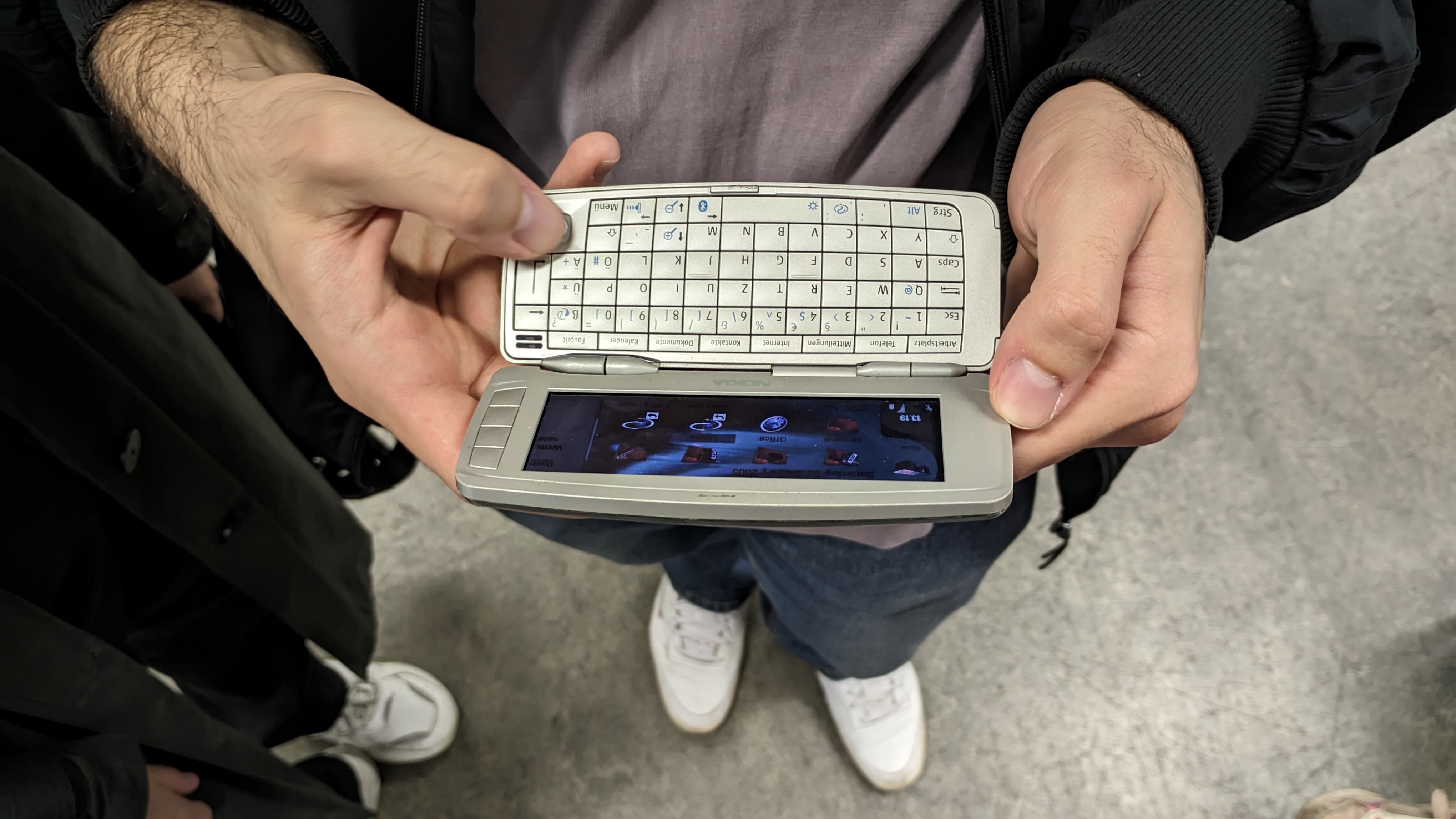 Examining the Nokia 9300 communicator with interest
Examining the Nokia 9300 communicator with interest
There were also many children at the exhibition. I was always happy to hand them a smartphone or PDA with Bubble Breaker, but their attention soon drifted to consoles and computers with arcade games like Street Fighter or the legendary Pong.
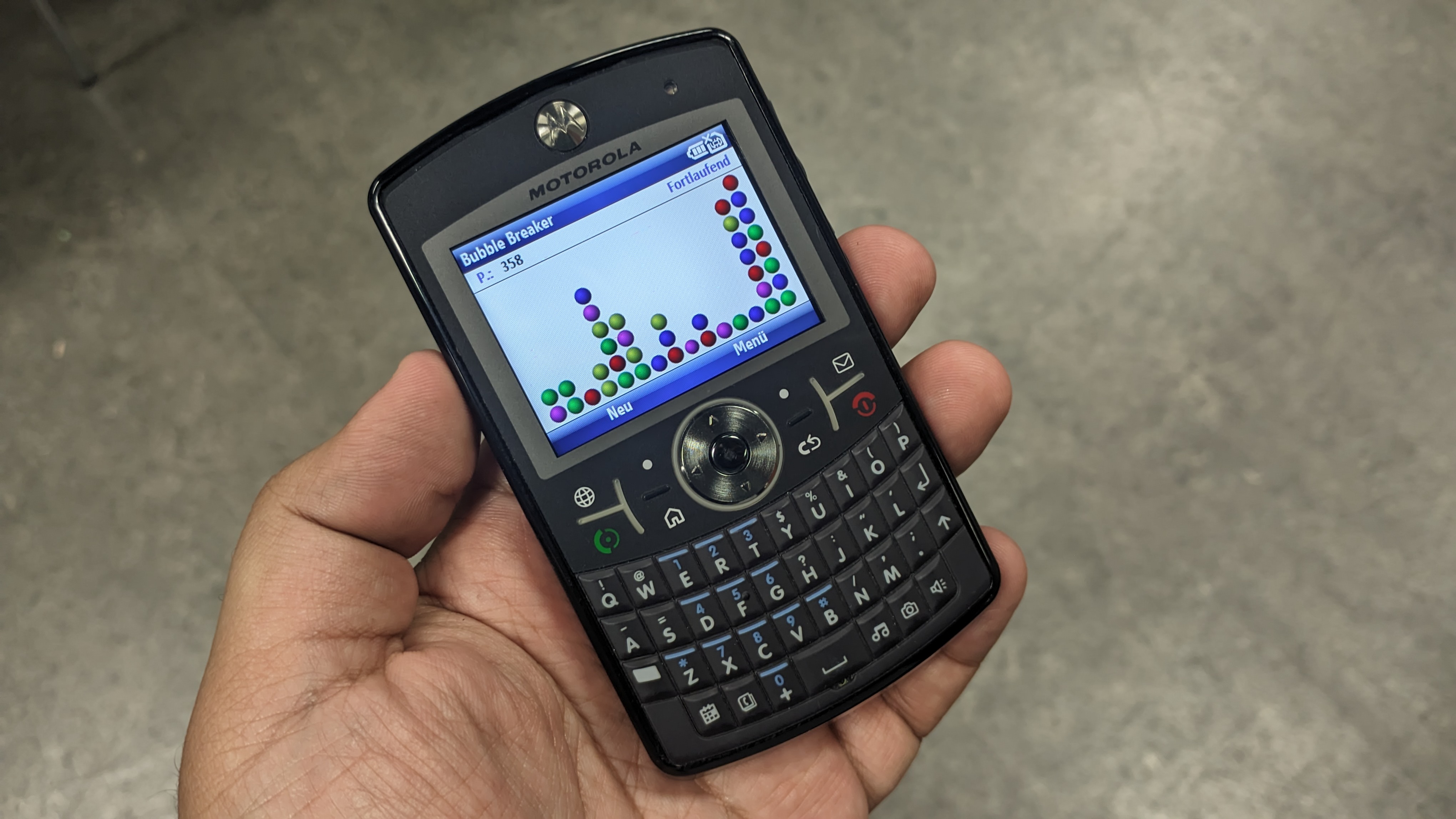 The one and only Bubble Breaker
The one and only Bubble Breaker
The highlight of the event was the gifts from guests: I brought 63 devices and left with about 70, a collection of varied and interesting items! For example, I never had a classic BlackBerry or a phone on the Samsung Bada platform. All of this was given to me freely, for which I am deeply grateful. Next year, these gifts, after being cleaned of personal data, will, of course, become part of my exhibition.
Other Wonderful Festival Exhibits
Naturally, I wasn’t the only cool one at the festival with loads of interesting gadgets. Both visitors and booth owners had plenty to show. Someone brought a Palm PDA with an MP3 player inserted via an expansion slot that used the main device solely as a power source. Another was showcasing the Psion 5 MX Pro, an enhanced version of my PDA that featured an email client and browser. Yet another pulled out a Nokia E90, which they still actively use for note-taking. The most fascinating device for me was a test prototype of the first iPhone, loaded with diagnostic software and quirky images. The developers must have had a lot of fun with it. I own a Motorola RIZR Z10 engineering prototype with similar software. One day, I’ll capture it in action — it's an absolute freak show!
It Wouldn’t Be Complete Without Music!
The marathon wouldn’t have been complete if I hadn’t rushed to a concert before or after the festival. Last time, I dashed straight from work to catch IAMX in Leipzig. This time, the incredible Eivør Pálsdóttir performed in Berlin, a Faroese enchantress blending pop, rock, synthwave, opera, and ancient Scandinavian throat singing. It’s hard to describe this magic in words — just watch.
Conclusion
Two days, ten hours each, filled with non-stop conversations, stories, laughter, smiles, and nostalgia. It was all about momentarily escaping the hectic, chaotic world and revisiting a time when life felt simpler and clearer — when the internet and its thin clients hadn’t yet been commoditized by profit-seeking corporations, when individuality and self-expression, even through pocket devices, still held meaning. Although my booth didn’t win any awards at the festival, I still won the ultimate prize: they’ll be expecting me back at this event in 2025. See you then!
P.S.: My collection now has an online page where you can view (almost) all items and read the stories behind them. I plan to update and maintain it as time and energy allow.
Sat, 26 Oct 2024 17:21:59 +0200
RSS // Telegram // Статистика

